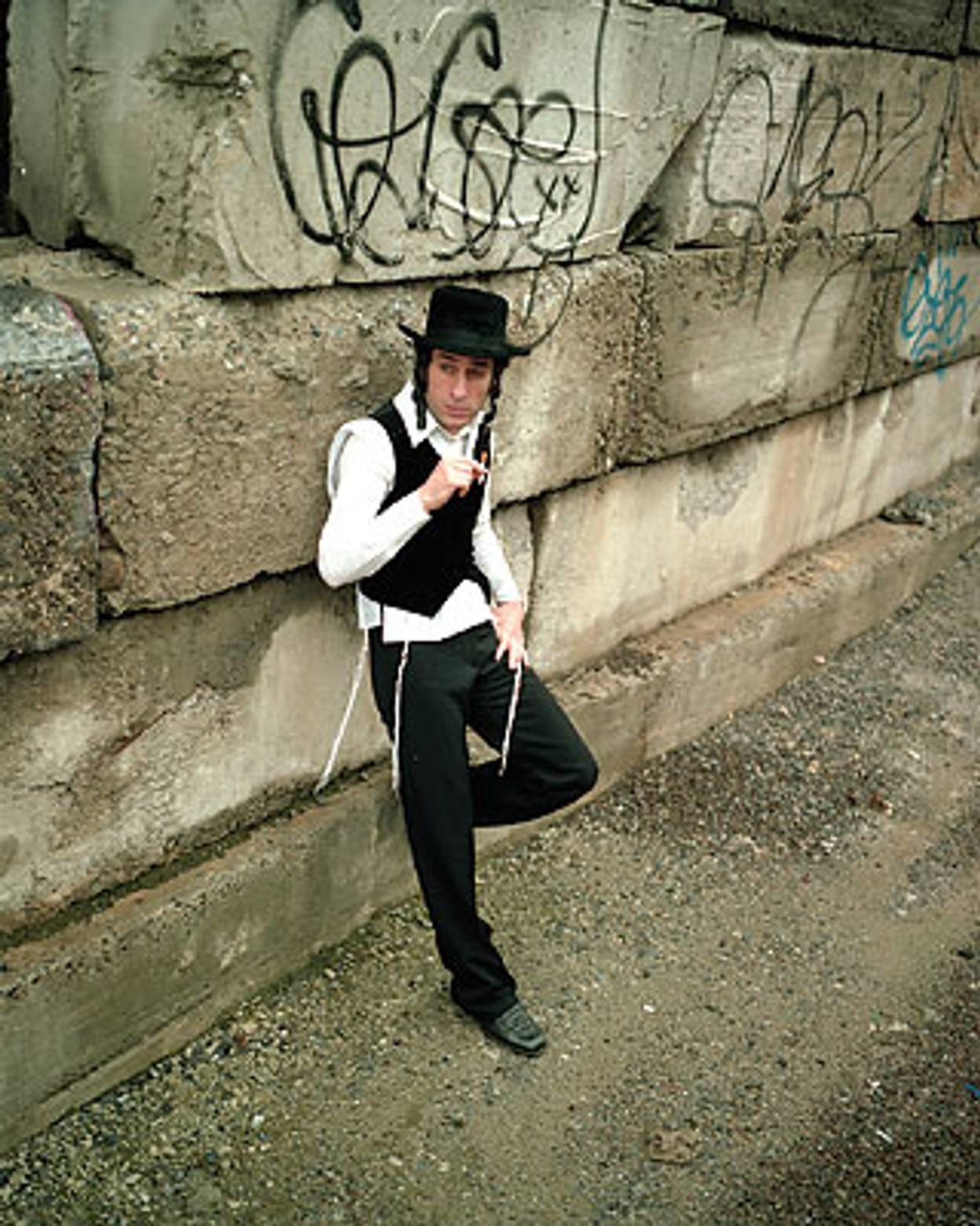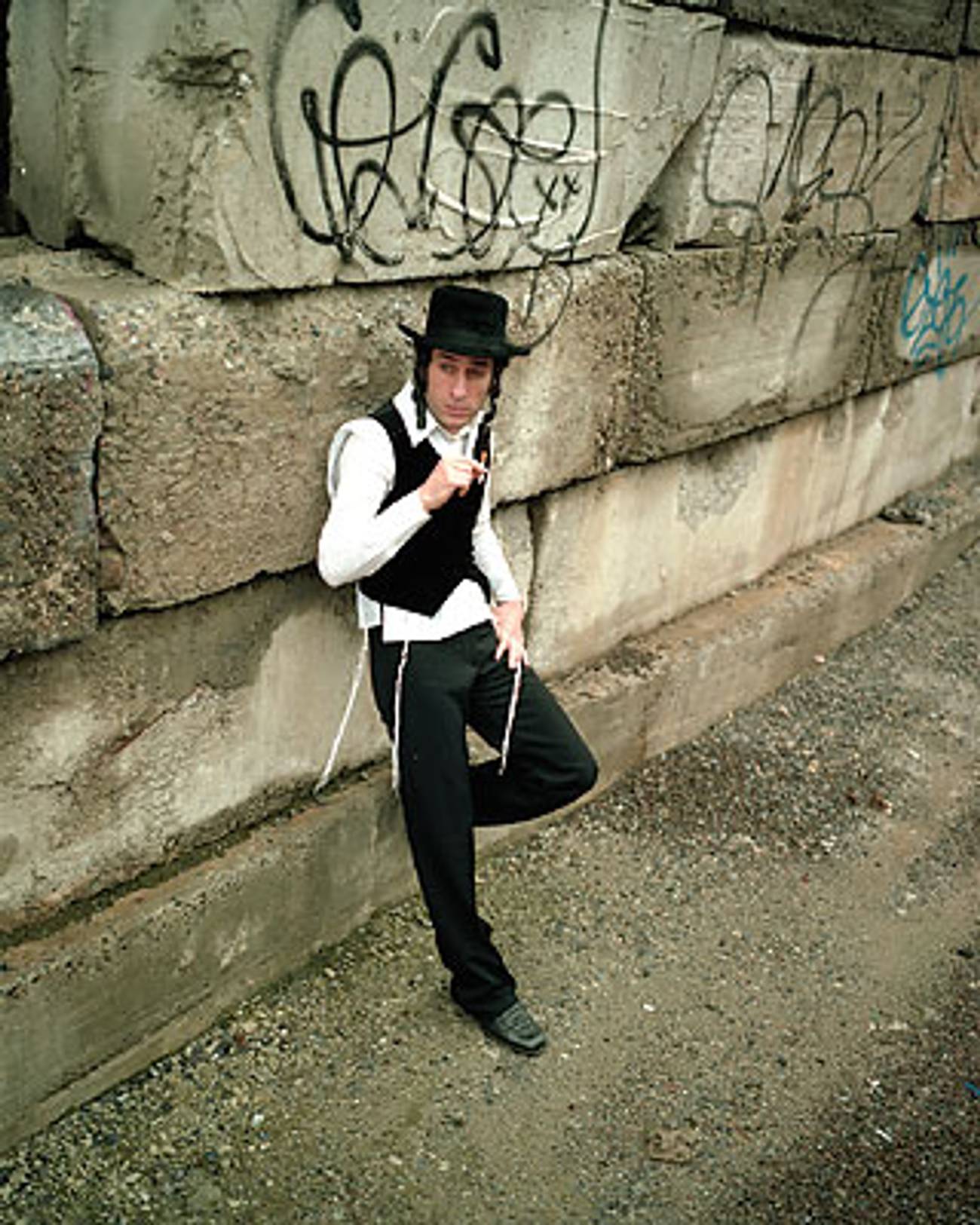Cultural Evolution
What exactly is “post-Jewish” art?




In 2000, Los Angeles artist Joel Tauber dug a hole in the California desert, stood naked inside it, and buried himself up to his shoulders before beginning to meditate. Raised (but no longer) Orthodox, he felt a “powerful intuition”—perhaps, he thought, divine—to place himself “inside the earth,” as he describes it in the video prologue to his oddly provocative installation Seven Attempts to Make a Ritual. He would try six more times to realize this impulse to commune with nature—sometimes clothed, once in a cave.
The videos and photographs of this eccentric quest provide a metaphor for one of the most exciting and anxiety-inducing qualities of the exhibition in which they’re currently being shown, “The New Authentics: Artists of the Post-Jewish Generation.” Most of the artists in the show have never before had their work shown in a Jewish context, and still seem to be working out their identities. Like Tauber, they stand alone in private caves, some that they’ve dug for themselves, others that they’ve stumbled upon.
This often-thrilling exhibition opened in Chicago last November as the inaugural show of the Spertus Museum’s new home, and has since moved to the Rose Art Museum at Brandeis University, where it will run until July 27. Its organizer, the Spertus Museum’s senior curator, Staci Boris, says she wanted “to take the temperature of the art world,” to see whether and how a new generation of artists, most born in the 1960s and ’70s, were engaging with Jewishness in their work. “The New Authentics” might be seen as a sequel of sorts to the Jewish Museum’s landmark 1996 show “Too Jewish: Challenging Traditional Identities.” That exhibit, curated by Norman Kleeblatt, included wry, deftly confrontational works in which artists tried to insert Jewishness into realms of culture from which it had traditionally been excluded; among them Deborah Kass’s Jewish Jackie series (silk-screened, Warhol-style images of ’60s Barbra Streisand) and Cary Leibowitz and Rhonda Lieberman’s Chanel Hanukkah (an invented line of designer holiday accessories such as a menorah fashioned from a gold handbag, with lipstick for candles). “Too Jewish” came at the height of Clinton-era multiculturalism, but today its focus on bodily stereotypes, assimilation, popular culture, and ritual can seem a little narrow and dated.
“The New Authentics,” by contrast, sometimes feels curiously unfocused, and that’s part of the point: to force us to wonder what constitutes and signifies Jewishness both on the canvas and off. Boris chose the term “post-Jewish” as a way to get the word “Jewish” somewhere in the title while not categorizing the artists or their work too rigidly. She took her cue from a 2001 exhibit at the Studio Museum of Harlem, “Freestyle,” which curator Thelma Golden conceived as “post-black.” Boris also connected with Berkeley professor David Hollinger’s prophetic 1995 book Postethnic America: Beyond Multiculturalism, in which he looks forward to a moment when Americans will be able to appreciate differences without prescribing or limiting them. For Boris, being “post-Jewish” also means integrating a host of affiliations. “I chose artists that were making work that showed identity as fluid, that showed that they were questioning their identities,” she says.
That multiplicity of backgrounds might also explain why the works in “The New Authentics” tend to avoid the kind of pop iconography that typified much of “Too Jewish”—you won’t find Bob Dylan or Manischewitz here. What popular culture you will find tends to be more allusive than head-on, as in Lilah Freedland’s extraordinary dream as though you’ll live forever, live as though you’ll die today. The photograph, titled after a James Dean quote, shows a baby-faced and beardless young Hasid with a cigarette halfway to his lips, leaning against a graffiti-covered wall of what appears to be ancient stone. The image recalls not only countless images of Dean himself, but any number of photos of Hasidic Jews praying before the Western Wall. Perhaps Freedland treads on sacreligious ground when she imbues a Hasidic man with a rebellious, even erotic mystery, but she also makes him less foreign, blurring the boundaries between secular and spiritual.
Laura Kina takes a more direct, though no less original approach. Kina, a convert to Judaism raised by a Japanese American father and a Spanish American mother, turns life-size canvases of three refrigerators into a neat commentary on class, family, home, and the construction of identity. One refrigerator, a humble white Frigidaire, titled and presumably belonging to The Kina-Aronsons, is covered with drawings by their daughter Ariel, a holiday greeting from newly married relatives Ayako and Miles, and magnetic poetry with words like “schmooze,” “kibitzer,” and “mish-mash.” Another refrigerator, belonging to The Aronsons, is camouflaged behind wood cabinetry, and similarly covered with Ariel’s artwork, wishing, “Get Well Soon!” and “Happy Hannukka.” But the last, The Rosenfelds, is made of shining steel, and free of any artwork or magnets—any markers of its owners—and resembles a Mark Rothko painting crossed with one of Barnett Newman’s “zips.” The three refrigerators cut to the core of the debates at play in “The New Authentics”—how do artists and individuals construct and signify Jewishness to outsiders, especially in a century where ethnic, national, and religious identities are increasingly blurred? Is there something more Jewish about a work like The Kina-Aronsons, with jumbled Yiddish and English literally on its surface, over less representational works like those recalled by The Rosenfelds? Is there something more or less Jewish about the families who actually own those refrigerators?
If “The New Authentics” does what it should, viewers will come away with more questions than answers, whether about the interplay of form, content, and context, or the relationship between “Jewish” and “post-Jewish” art. Karl Haendel’s installation, for one, seems conspicuously lacking in overt Jewish content, except for a single sign reading, “Israel pulls out of Gaza, Gaza not pregnant,” among others saying “We Miss Clinton” and “Let Marys Marry.” Yet, while Haendel was initially reluctant to be involved in a Jewish exhibit, says Boris, “I see his work as almost the most Jewish of all, like if you think of this stereotypical New York liberal Jew who reads The New Yorker magazine and is involved politically in changing the world.” Haendel’s work, of course, is as much a play on that New York Jewish stereotype as it is a proclamation; the question remains hanging (a backwards question mark literally hangs on the wall of Haendel’s installation) as to whether there is anything peculiarly Jewish about those views, or if that’s a narrow reading of the piece.
Another of the exhibition’s most original and striking works is a small world…, an installation by Jennifer Zackin and Sanford Biggs. Zackin is from a white, East Coast family; Biggs is from a black, West Coast family. Silent video montages of their respective middle-class childhoods are shown side by side in a room that looks uncannily like a ’70s den lined with faux-wood paneling—Jennifer takes piano lessons, Sanford takes piano lessons, Jennifer goes to Disney World, Sanford goes to Disneyland, Jennifer celebrates Hanukkah, Sanford celebrates Christmas. The implication is that American culture and consumerism matter more in shaping identities and experiences than individual religions or ethnicities; at the same time, you can’t help wondering what footage wound up on the cutting-room floor, and which experiences weren’t filmed at all.
Where religion finally fits into all this is another of the persistent questions posed by “The New Authentics.” There are Kina and Zackin’s references to Hanukkah; Fawn Krieger’s prints pairing milk and meat in ever stranger (and less kosher) combinations, and Freedland’s hysterical dip ya karpas, a pinup variation on the Passover ritual—but for the most part religion is pushed to the margins. Which is not to say “The New Authentics” lacks a spiritual undercurrent, only a normative Jewish one. Matthew Girson’s two paintings of hurricane patterns seen from space, Satellite View #2 and #3, alongside Dizzy Heights V, a self-portrait of the back of Girson’s head, turn swirling patterns of clouds and hair into sublime sights. And again, there’s Tauber’s Seven Attempts to Make a Ritual, which looks even more emphatically toward nature for a feeling of the divine.
It seems like no accident that so many of the figures represented in “The New Authentics” find themselves alone, from Tauber, to Freedland’s rebellious Hasid, to David Altmejd’s The Settler, which depicts one of the artist’s trademark decaying werewolves, lying awkwardly on its back atop a mirrored platform, crystalline spears piercing—or are they emanating from?—his broken body (that last piece can be read as a cautionary tale, affirming that the immigrant always remains “the other,” a monster in a world of men). Overall, what’s distinctly absent in the exhibit is any sense of community larger than one’s own family—and as Kina’s refrigerators show, even a single family can resemble a collage of unique individuals more than a composed portrait. As Boris explains, the exhibition ultimately focuses on individuals. “We discuss here at the museum the Jewish community in Chicago,” she says. “I don’t know who that is. Does that mean every single person who’s Jewish, does that mean the Jewish institutional organization that speaks for the Jews? If I disagree with them, then am I not part of that community? Each individual has his or her own way of engaging with Jewishness, and that in itself is the hallmark of Jewish identity, of identity period, in the twenty-first century.”
“The New Authentics” does not merely take the temperature of a new generation, but points the way for those to come, pressing at communal boundaries, creating new affiliations even as it disrupts others. But no revolution comes without cost. Leaving the fold may be liberating, but as Altmejd’s decaying werewolf reminds us, it can be painfully lonely, too.